Architecture of Indonesia
| Part of a series on the |
| Culture of Indonesia |
|---|
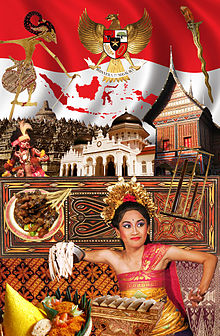 |
| People |
| Languages |
| Mythology and folklore |
| Cuisine |
|
Literature |
| Music and performing arts |
| Sport |
The architecture of Indonesia reflects the diversity of cultural, historical, and geographic influences that have shaped Indonesia as a whole. Invaders, colonizers, missionaries, merchants, and traders brought cultural changes that had a profound effect on building styles and techniques.
Numbers of Indonesian
Traditionally, the most significant foreign influence has been India. However, Chinese, Arab, and European influences have also played significant roles in shaping Indonesian architecture. Religious architecture varies from indigenous forms to mosques, temples, and churches. The sultans and other rulers built palaces. There is a substantial legacy of colonial architecture in Indonesian cities. Independent Indonesia has seen the development of new paradigms for postmodern and contemporary architecture.
Traditional vernacular architecture
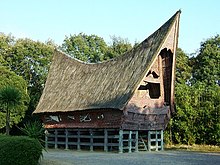
Ethnic groups in Indonesia are often associated with their distinctive form of rumah adat.[2] The houses are at the centre of a web of customs, social relations, traditional laws, taboos, myths, and religions that bind the villagers together. The house provides the main focus for the family and its community and is the point of departure for many activities of its residents.[3] Villagers build their own homes, or a community will pool their resources for a structure built under the direction of a master builder and/or a carpenter.[2]
The majority of Indonesian peoples share a common
The norm is for a post, beam, and lintel structural system that takes load straight to the ground with either
Traditional dwellings have developed to respond to Indonesia's hot and wet monsoon climate. As is common throughout
Examples
-
An avenue of houses in a Torajan village.
-
Traditional Minangkabau house in West Sumatra.
-
Traditional house in Nias, North Sumatra
-
Bugis house, South Sulawesi
-
Traditional Sumba house in West Sumba, East Nusa Tenggara.
Some of the more significant and distinctive rumah adat include:
- Rumoh Aceh, the grandest traditional houses of Aceh.
- Batak architecture (North Sumatra) includes the boat-shaped jabu homes of the Toba Batak people, with dominating carved gables and dramatic oversized roof, and are based on an ancient model.
- The Minangkabau of West Sumatra build the Rumah Gadang, distinctive for their multiple gables with dramatically upsweeping ridge ends.
- The homes of Nias peoples include the omo sebua chiefs' houses built on massive ironwood pillars with towering roofs. Not only are they almost impregnable to attack in former tribal warfare, but flexible nail-less construction provide proven earthquake durability.
- Malaytraditional houses built on stilts of Sumatra, Borneo and Malay Peninsula.
- The Riau region is characterised by villages built on stilts over waterways.
- Unlike most South East Asian vernacular homes, Javanese traditional houses are not built on piles, and have become the Indonesian vernacular style most influenced by European architectural elements.
- The Bubungan Tinggi, with their steeply pitched roofs, are the large homes of Banjarese royalty and aristocrats in South Kalimantan.
- Traditional Balinese homes are a collection of individual, largely open structures (including separate structures for the kitchen, sleeping areas, bathing areas and shrine) within a high-walled garden compound.
- The Sasak people of Lombok build lumbung, pile-built bonnet-roofed rice barns, that are often more distinctive and elaborate than their houses (see Sasak architecture).
- Dayak people traditionally live in communal longhouses that are built on piles. The houses can exceed 300 m in length, in some cases forming a whole village.
- The , houses built on piles and dwarfed by massive exaggerated-pitch saddle roofs.
- Rumah adat on Sumba have distinctive thatched "high hat" roofs and are wrapped with sheltered verandahs.
- The thatcheddome roofs.
Decline
The numbers of rumah adat are decreasing across Indonesia. This trend dates from the colonial period, with the Dutch generally viewing traditional architecture as unhygienic, and being based on traditional religious practises seen as dubious by the Dutch.
Exposure to the market economy made the construction of labour-intensive rumah adat, such as the Batak house, extremely expensive (previously villages would work together to construct new homes) to build and maintain. Hardwoods are no longer a free resource to be gathered as needed from nearby forests, but are now generally too-expensive.[9] The great majority of Indonesians now dwell in generic modern buildings rather than traditional rumah adat.
Hindu-Buddhist architecture

A number of often large and sophisticated religious structures (known as
Although brick was used to some extent during Indonesia's classical era, it was the
Balinese architecture contains many elements of ancient Hindu-Buddhist architecture, mostly are the heritage from Majapahit architectural influences. Among others are the bale pavilion, Meru tower, paduraksa and candi bentar gates. Hindu-Buddhist architecture mostly were constructed between 8th to 15th-century, with subsequent tradition in Balinese architecture. However, typical ancient Javanese Hindu-Buddhist architecture has been the source of inspiration and recreated in contemporary architecture. For example, Ganjuran Church in Bantul, Yogyakarta contains a candi-like Hindu-style shrine dedicated to Jesus.
-
Candi bentar split gate marking entrance into a compound
-
A shrine dedicated to Jesus in Ganjuran Church recreated Javanese Hindu-style temple
Islamic architecture
Although
Vernacular mosque architecture
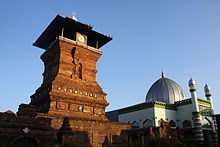
By the fifteenth century,
In Sumatra, the old mosques in Minangkabau lands of West Sumatra demonstrate local tradition of vernacular Minangkabau architecture. The example includes the old mosque of Bingkudu in Agam Regency,[11] and also Masjid Lubuk Bauk in Batipuh, West Sumatra.[12]
In the 19th century, the sultanates of Indonesian archipelago began to adopt and absorb foreign influences of
-
Late 19th-century village mosque (surau nagari) of Lubuk Bauk in Batipuh, West Sumatra.
-
Demak Great Mosque, typical Javanese vernacular mosque architecture with multi-tiered roof
-
The 16th-century Great Mosque of Banten with a minaret that resembles a lighthouse.
-
A paduraksa-like structure marking the entrance to the mosque compound.
-
Kauman Great Mosque, the royal mosque of Yogyakarta.
Palace architecture
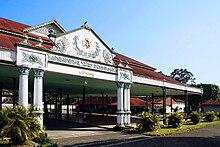
Istana (or "
Similar to trends in domestic architecture, the last two centuries have seen the use of European elements in combination with traditional elements, albeit at a far more sophisticated and opulent level compared to domestic homes.
In the Javanese palaces the
-
Pendhapa (pavilion) in Keraton Kasepuhan.
-
Bale gamelan pavilion within Puri Ubud compound
-
Kori Kamandungan, an entrance gate into Surakarta kraton
-
The grand pendopo of Pura Mangkunegaran
-
Halaman of Maimun Palace
Colonial architecture
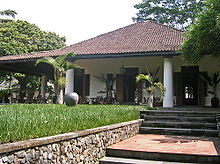
The 16th and 17th centuries saw the arrival of European powers in Indonesia who used masonry for much of their construction. Previously timber and its by-products had been almost exclusively used in Indonesia, with the exception of some major religious and palace architecture. One of the first major Dutch settlements was Batavia (later renamed Jakarta) which in the 17th and 18th centuries was a fortified brick and masonry city.[13]
For almost two centuries, the colonialists did little to adapt their European architectural habits to the tropical climate.
Although row houses, canals and enclosed solid walls were first thought as protection against tropical diseases coming from tropical air, years later the Dutch learnt to adapt their architectural style with local building features (long eaves,
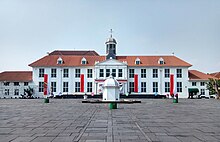
At the end of the 19th century, great changes were happening across much of colonial Indonesia, particularly
.Colonial rule was never as extensive on the island of Bali as it was on Java— it was only in 1906, for example, that the Dutch gained full control of the island—and consequently the island only has a limited stock of colonial architecture. Singaraja, the island's former colonial capital and port, has a number of art-deco kantor style homes, tree-lined streets and dilapidated warehouses. The hill town of Munduk, a town amongst plantations established by the Dutch, is Bali's only other significant group of colonial architecture; a number of mini mansions in the Balinese-Dutch style still survive.[19]
The lack of development due to the
Native architecture was arguably more influenced by the new European ideas than colonial architecture was influenced by Indonesian styles; and these Western elements continue to be a dominant influence on Indonesia's built environment today.
Early twentieth century modernisms are still very evident across much of Indonesia, especially in urban areas. The 1930s world depression was devastating and was followed by another decade of war, revolution and struggle, which restricted the development of built environments.
-
This pre-war Bandung home is an example of 20th century Indonesian Dutch Colonial styles.
-
The city hall Gedung Sate of Bandung
-
Pasar Gede Harjonagoro in Surakarta.
-
Jakarta Kota railway station, an example of Art Deco style in Batavia
-
Bakorwil Pamekasan in Art Deco style with native Indonesian architecture
-
Blenduk Church in Semarang
-
Old City Hall of Medan
-
Bank Indonesia (formerly De Javasche Bank), Yogyakarta
-
Gedung Sabahu, Bandung
-
Jakarta Cathedral, an example of Gothic Revival architecture
Post independence architecture
The Javanese art-deco style from the 1920s became the root for the first Indonesian national style in the 1950s.[
Let us prove that we can also build the country like the Europeans and Americans do because we are equal
Despite the new country's economic woes, government-funded
- A clover-leaf interchange bridge.
- A broad boulevard in Jakarta, Jalan Jenderal Sudirman.
- Four high-rise hotels including the famous Hotel Indonesia.
- A new parliament building.
- The 127 000-seat Bung Karno Stadium.
- Numerous monuments including The National Monument.
- Istiqlal Mosque the largest mosque in Southeast Asia.
The 1950s
When development picked up in the early 1970s under
-
International style of Hotel Indonesia
-
The old headquarter of Bank Indonesia byFrederich Silaban
-
MPR/DPR building in Indonesia
The 1970s saw the Indonesian government promote indigenous Indonesian forms. Constructed in 1975, the
Despite this commendable effort to try to define Indonesian architecture, through drawing inspirations from native elements of Indonesian vernacular architecture and traditions, the practice and results might not be fulfilling expectations. Sometimes the result is mediocre, criticized as superficial addition upon modern building – by merely applying traditional ornaments or just attaching traditional roofs. Nevertheless, there are some exceptional result of this effort, such as the original design of
-
City Hall in Bukittinggi with traditional Minangkabau elements with modern architecture
-
Anjung Seni Idrus Tintin inMalay housesarchitecture
-
The West Sumatra representative office in Jakarta with bagonjong roof of Minangkabau architecture
-
pendopopavilions
-
Ngurah Rai International Airport combines traditional Balinese elements with modern architecture
-
A resort in North Toraja with traditional Torajan designs
Contemporary architecture
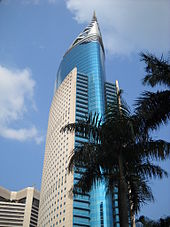
The 1970s, 1980s and 1990s saw foreign investment and economic growth; large construction booms brought major changes to Indonesian cities, including the replacement of the early twentieth styles with late
See also
- Influence of Indian Hindu temple architecture on Southeast Asia
- History of Indian influence on Southeast Asia
- Landhuis
- Indies Empire style
- New Indies Style
Notes
- ISBN 9789971692926.
- ^ a b c Dawson (1994), p. 10
- ^ a b c d Dawson (1994), p. 8
- ^ a b c d The Oxford Companion to Architecture, Volume 1, p. 462.
- ^ Dawson (1994), p. 12
- ^ Dawson (1994), pp. 10–11
- ^ Dawson (1994), p. 11
- ^ Nas, p. 348
- ^ a b Nas, p. 347
- ^ Transformation of Building Form: Development of Traditional Dwelling of the Ngada, Central Flores Island – Toga H Pandjaitan Archived 10 August 2011 at the Wayback Machine
- ^ Dina Fatimah. "KAJIAN Arsitektur pada Masjid Bingkudu di Minangkabau dilihat dari Aspek Nilai dan Makna" (PDF). Archived from the original (PDF) on 11 December 2015.
- ^ "Masjid Lubuk Bauk". Melayu Online (in Indonesian). Archived from the original on 11 December 2015. Retrieved 10 December 2015.
- ^ Schoppert (1997), pp. 38–39
- ^ W. Wangsadinata & T.K. Djajasudarma (1995). "Architectural Design Consideration for Modern Buildings in Indonesia" (PDF). INDOBEX Conf. on Building Construction Technology for the Future: Construction Technology for Highrises & Intelligence Buildings. Jakarta. Archived from the original (PDF) on 14 June 2007. Retrieved 18 January 2007.
- ^ a b Schoppert (1997), pp. 72–77
- ^ Schoppert (1997), pp. 104–105
- ^ Schoppert (1997), pp. 102–103
- ^ Schoppert (1997), pp. 102–105
- ISBN 981-4068-25-X.
- ^ a b Schoppert (1997), p. 105
- ^ For addresses and speeches during his presidency, his State addresses on 17 August each year are mostly available in cassette form. A two-volume book entitled Di Bawah Bendera Revolusi (Under the Flags of Revolution) (n.d; n.p) is a collection of his writings and some of that state address.
- ISBN 0-415-23615-0
- ^ WHEN WEST MEETS EAST: One Century of Architecture in Indonesia (1890s–1990s) Archived 28 April 2011 at the Wayback Machine, Josef Prijotomo, 1996, Surabaya, Indonesia
- ^ Schoppert (1997), page 105
- ^ "Setiap Gedung Punya Cerita". Setiap Gedung Punya Cerita (in Indonesian). Retrieved 11 February 2023.
Bibliography
- Beal, Gillian (202). Island Style: Tropical Dream Houses in Indonesia. Hong Kong: Periplis Editions Ltd. ISBN 962-593-415-4.
- Dawson, B., Gillow, J., The Traditional Architecture of Indonesia, 1994 Thames and Hudson Ltd, London, ISBN 0-500-34132-X
- Helmi, Rio; Walker, Barbara (1995). Bali Style. London: Times Editions Pte Ltd. ISBN 0-500-23714-X.
- Schoppert, P., Damais, S., Java Style, 1997, Didier Millet, Paris, 207 pages, ISBN 962-593-232-1
- Wijaya, M., Architecture of Bali: A source book of traditional and modern forms, 2002 Archipelago Press, Singapore, 224 pages, ISBN 981-4068-25-X
- Peter JM. Nas, The House in Indonesia
External links
- Asian Historical Architecture, Indonesia Section (Borobudur, Prambanan, and houses and graveyard of Batak Karo).
- Majapahit architecture.
- Visual Database of Modern Dutch Tropical Architecture in Indonesia.
- Archnet Digital Library on Indonesia.
- Architecture of Tana Toraja
- Inside Austronesian Houses: Perspectives on domestic designs for living
- Jengki:Homes for a Free Indonesia Jakarta Globe
- Balinese Home Design












































